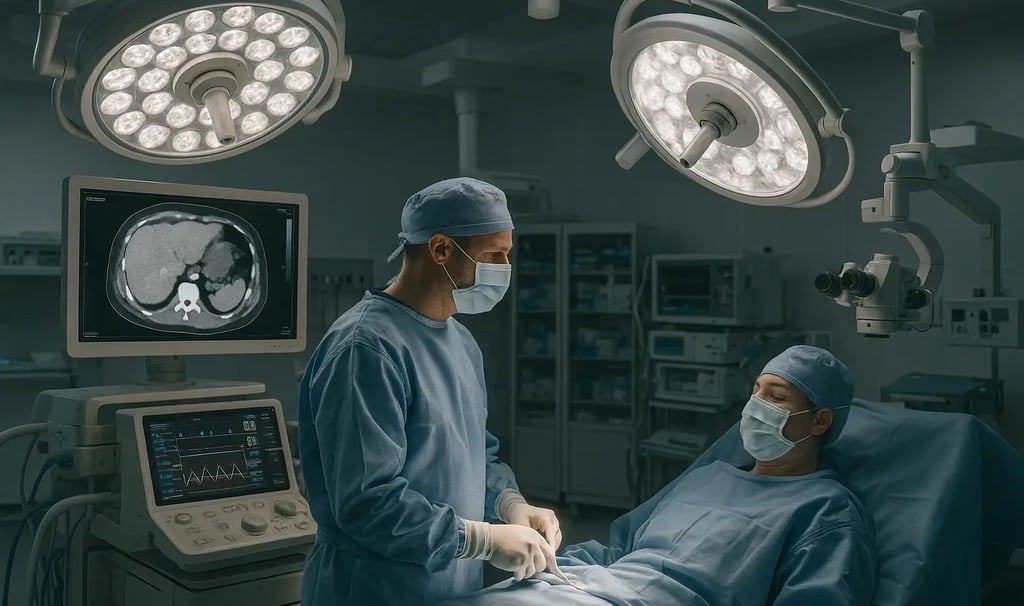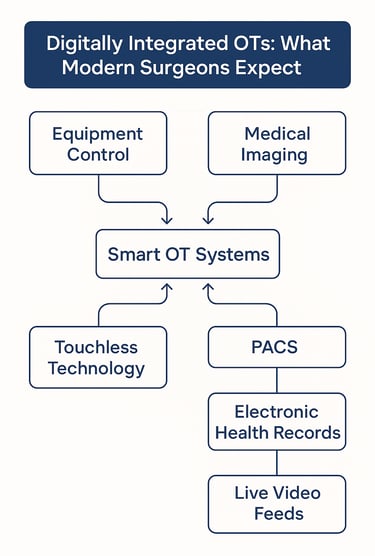Digitally Integrated OTs: What Modern Surgeons Expect
Discover what digitally integrated Operation Theatres (OTs) are, why they matter, and what features modern surgeons expect. Explore key technologies, design elements, and the role of digital OT architecture in advancing surgical outcomes.
7/18/20253 min read


The New Age of Surgical Environments
In today’s high-precision surgical landscape, the operation theatre is no longer just a physical space; it's a digitally enabled environment designed to support seamless procedures, reduce human error, and enhance surgical outcomes. Modern surgeons expect more than just sterility and good lighting. They demand digitally integrated OTs that streamline workflow, ensure real-time data access, and support advanced imaging and telemedicine.
As the healthcare sector in India rapidly upgrades its infrastructure, digitally integrated OTs are becoming a core requirement in both new hospital projects and renovation plans. For architectural firms and healthcare planners, understanding this evolution is critical.
2. What Modern Surgeons Expect in a Smart OT
Surgeons today are not just skilled operators; they are technology adopters who rely on digital systems for better diagnostics, precision, and documentation. Here are the key features modern surgeons look for:
a. Real-Time Imaging and Data Access
Surgeons need instant access to patient scans, live imaging (e.g., fluoroscopy or laparoscopic camera feeds), and electronic health records (EHRs). Integrated OTs allow this data to be displayed on wall-mounted touchscreens or ceiling-mounted monitors.
b. Seamless Communication
Integrated OTs are often equipped with intercom systems, telemedicine links, and video conferencing capabilities, enabling remote consultations and live case sharing.
c. Workflow Automation
Touchless sensors for doors, lights, and water taps, along with centralized control panels, help maintain sterility while improving workflow efficiency. This is especially crucial during long surgeries.
d. Centralized Environment Control
Surgeons appreciate the ability to control lighting intensity, color temperature, air pressure settings, and temperature via smart panels without leaving the sterile field.
3. Designing for Integration: Architectural Considerations
Digitally integrated OTs require meticulous coordination between architects, MEP engineers, biomedical teams, and IT specialists. From planning conduits for data cables to ensuring electromagnetic compatibility, every detail matters.
a. Space Planning
Space must accommodate:
Ceiling-mounted equipment arms and boom systems
Wall-integrated screens and panels
Cable management systems for safety and hygiene
b. HVAC and Electrical Integration
HVAC systems should integrate with occupancy sensors and laminar airflow for energy efficiency. Electrical layouts must support redundancy, ensuring critical systems stay operational during power outages.
c. Modular Adaptability
Modular wall panels can be designed with embedded data ports and touch interfaces, allowing easier upgrades to newer technologies in the future.
4. Benefits of Digitally Integrated OTs
For hospital administrators and surgical teams, the transition to digitally integrated OTs brings measurable advantages:
Improved surgical precision through real-time imaging
Faster decision-making via data integration and AI support
Higher sterility standards with automation and minimal touchpoints
Enhanced documentation with video recordings and digital logs
Scalability and future-readiness with modular, upgradeable systems
Conclusion: The Future Is Integrated
As India’s healthcare sector embraces digital transformation, digitally integrated OTs are no longer optional — they are the benchmark for quality, safety, and operational efficiency. For new hospitals or retrofitting projects, planning digital integration at the architectural stage ensures lower costs, higher compliance, and better patient outcomes.
At Archora, we specialize in hospital design that is future-ready and compliance-driven. Whether you’re building from scratch or modernizing an existing facility, we help you plan OTs that meet clinical, technological, and architectural excellence.
Need guidance for your hospital project? Contact Archora for a tailored consultation on designing smart, compliant OTs.The New Age of Surgical Environments


1. What Is a Digitally Integrated Operation Theatre?
A digitally integrated OT combines architectural design with advanced medical and IT systems to create a tech-enabled surgical ecosystem. It integrates various devices, data systems, imaging tools, and environmental controls into one centralized platform, often operated via touchscreens or control panels.
Core components include:
Centralized OT control panels
High-definition video recording and live streaming
PACS (Picture Archiving and Communication System) integration
Real-time vital monitoring and EMR access
Lighting and HVAC automation
Voice-activated controls and touchless doors
This level of integration not only improves surgical precision but also enhances communication among the surgical team and external consultants.

ARCHORA
Where Infrastructure Inspires Healing
Innovate
Inspire
© 2025. All rights reserved.
Create
